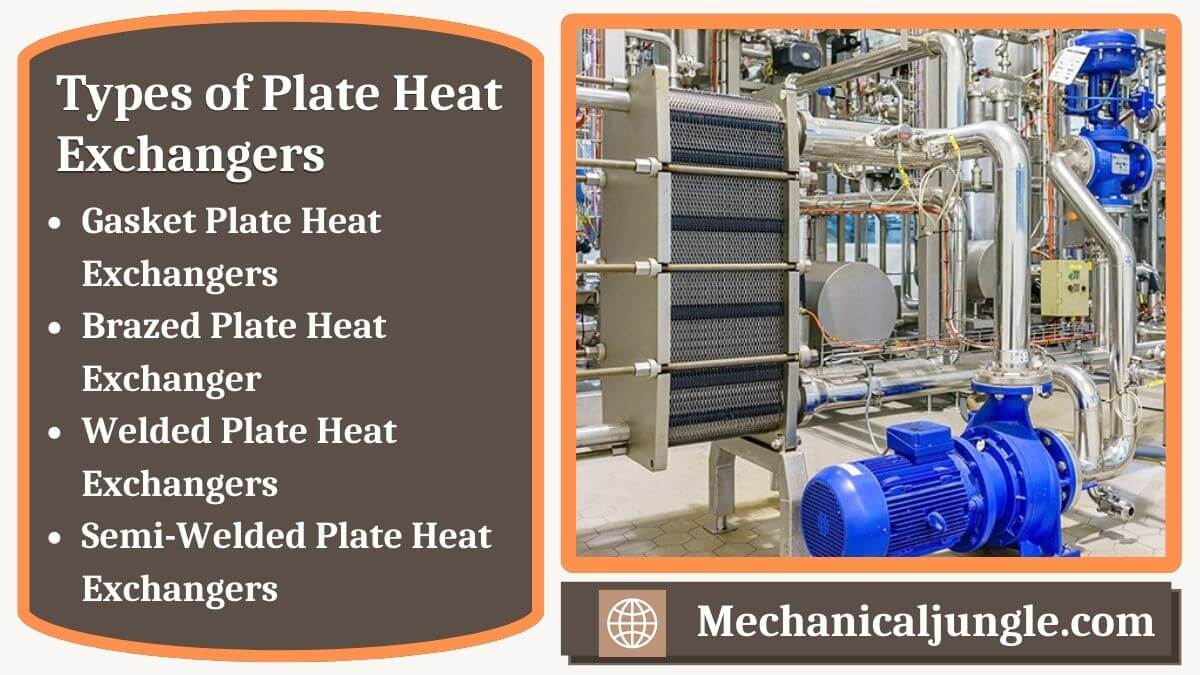
What Is a Plate Heat Exchanger?
Plate heat exchangers were firsts produced in the 1920s & have since been widely used in a large number of fields. Plates exchanger consists of a series of parallel plates that are placed one on top of the other to allow the formation of a series of channels for fluid to flow between them.
The space between two adjacent plates forms the channel in which the fluid flows. The inlet and outlet holes at the corners of the plates allow hot and cold liquids through alternating channels in the exchangers so that the plates are always in contact with the hot liquid on one side and the cold on the other.
Plate size can range from a few square centimeters (100 mm x 300 mm sides) to 2 or 3 squares meters (1000 mm x 2500 mm sides).
The number of plates in a singles exchanger ranges from only ten to several hundred, so the surface exchange areas reach thousands of square meters. The figure shows the flow of fluid inside the exchanger. Fluids split into several parallel currents and can produce a complete countercurrent.
Typically, these plates are corrugated to increase turbulence, and thermal exchange surface and to provide mechanical rigidity to the exchanger. Corrugation is obtained by cold forging of sheet metal with a thickness of 0.3 mm to 1 mm.
The most commonly used materials for plates are stainless steel (AISI 304, 316), titanium, and aluminum. The corrugation on the plates moves the fluid along a tortuous path, establishing a space between 1 and 5 millimeters between two adjacent plates B.
Fluids can cross the channel in series of fewer commons solutions or in parallel, creating a countercurrent or current configuration.
The serials configurations are used when there is a smalls flow rate for each fluid but a high heat jump; The biggest problem is with a high-pressure drop and an incomplete countercurrent.
Parallel configurations with countercurrent channels are used for high flow rates with moderate temperature drops and are the most widely used.
When there are large differences between the flow rates of the two fluids (or between the maximum permissible pressure drop), the exchanger is used to balance the values of the pressure drops or specific pressures by the fluid with low flow (or high loss). Can run the bar—flow rate in channels.
The figure shows different configurations: in parallel, in series, & mixed. One of the most common problems for plates heat exchangers is the erratic supply of all channels in parallel.
In fact, the fluid is distributed more in the first channels rather than in the last channels to balances the pressures drop. As the number of plates increases, the distributions also decline, resulting in a decrease in the overalls performance of the exchanger.
There are two basic types of plate heats exchangers: BPHE-brazed plate heat exchangers and PHE-plates heat exchangers.
What Is a Plate and Frames Heat Exchanger?
The concept behind heat exchangers is the use of pipe or other containment vessels to heat or cool a fluid by transferring heat between it and another fluid. In most cases, exchangers consist of a coiled pipe with one fluid passing through a chamber containing the other fluid.
Pipe walls are usually made of metals, or some other material with high thermal conductivity, to facilitate interchange, while the outer shell of the larger chamber is made of plastic or coated with thermal insulation, allowing heat to escape.
Most heat exchangers used in industry are shell and tube, air-cooled or plate and frame. Typically, plates & frame heat exchangers are used for liquid-liquid exchange under low to medium pressure.
However, gasket-free plate & frame heat exchangers can operate safely at high temperatures and pressures. Plate and frame heat exchangers offer flexibility as plates can be either joined or compressed for each different position.
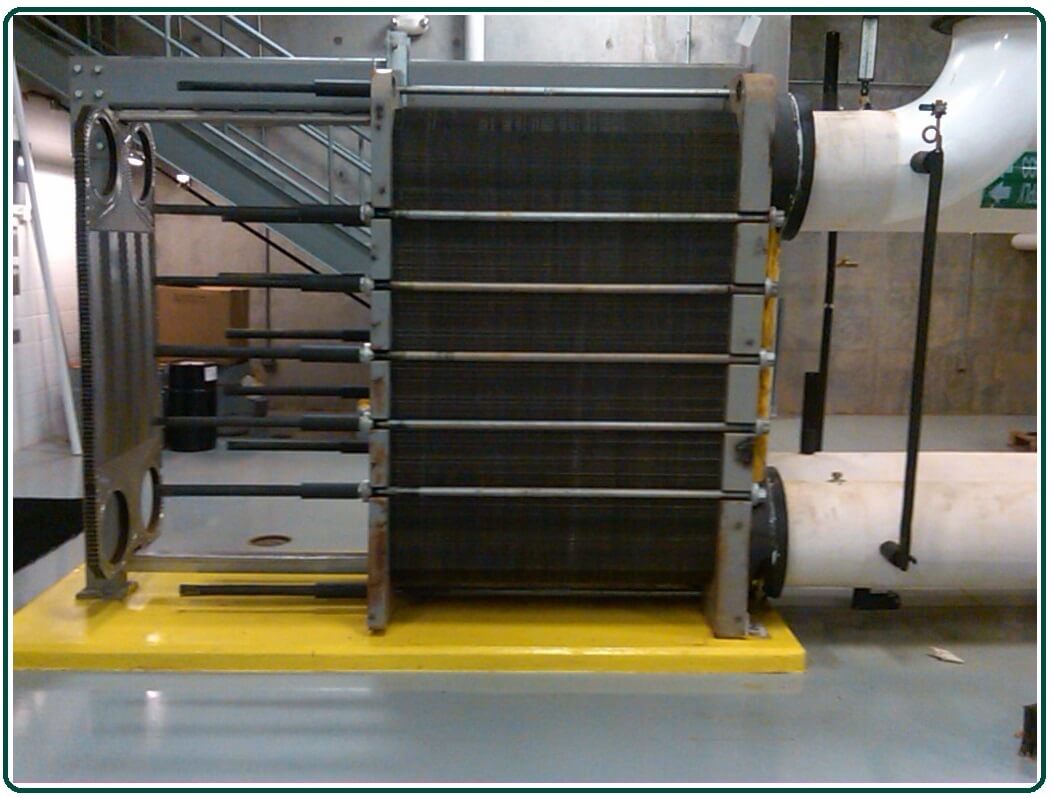
The plate frame heats exchanger is made of corrugated plates on a frame. This design produces high turbulence and high wall shear stress, both of which lead to a high heat transfer coefficient and high fouling resistance. Fluids travel within the heat exchanger.
Two currents flow counter current. A hot liquid flows down one plate while a cold liquid flows down another plate.
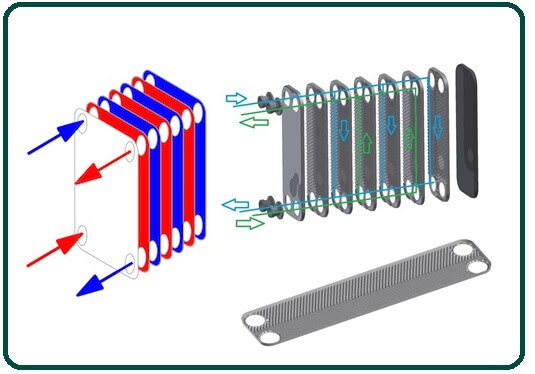
Gaskets ensure that cold fluid and hot fluid do not mix. Alternatives to traditional gasket seals include brazing and laser welding. The plates are stacked alternately to cause the counter current to flow. Several plates are clamped together and sealed at the edges.
The design allows the two liquids to flow in alternate directions and not mix. However, heaters can be transferred from one medium to another through plates.
Because gasket plate and frame exchangers are easy to clean, they are particularly useful for food and pharmaceutical processing, where a high degree of cleanliness is required.
Types of Plate Heat Exchangers:
There are four main types of plates heat exchangers:
#1. Gasket Plate Heat Exchangers
Gasket plate heat exchangers use high-quality gaskets and designs to seal the plates together and protect them from leaks. Plates can be easily removed for cleaning, expansions, or replacement purposes, leading to a significant reduction in maintenance costs.
#2. Brazed Plate Heat Exchanger
Brazed plates heat exchangers are used in many industrial & refrigeration applications. Due to the stainless steel plate structure with copper brazing, they are highly resistant to corrosion. Brazed plate heat exchangers are efficient & compact, making them an excellent economical option.
#3. Welded Plate Heat Exchangers
The welded plate heat exchanger is similar to gasket plate heat exchangers, but instead, the plates are welded together. They are extremely durable and ideal for transferring liquids containing high temperatures or corrosive material.
Since the plate is welded together, mechanical cleaning of the plates is not an option with plate and frame heat exchangers.
#4. Semi-Welded Plate Heat Exchangers
Semi-welded plate heat exchangers consist of a mixture of welded and gasketed plates. These consist of two pairs of plates that are welded together, which are then gasketed to the other joints, so one fluid path is welded, & the other fluid paths are gasketed.
This results in plate heat exchangers that are easier to service on one side and able to transfer fluids more rapidly on the other.
Semi-welded heat exchangers are perfect for transferring expensive materials because they have little risk of fluid loss. API Schmidt-Breton offers all four variants. Each type is suitable for many applications in different industrial sectors.
Alternatives to Plate and Frame Heat Exchangers:
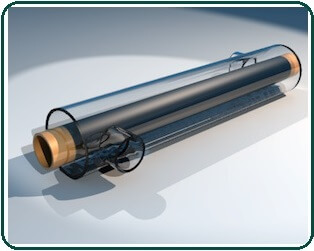
Plate heat exchangers are not the bests choice for all applications. In situations where there are extremes temperature differences between the two fluids, it is generally more cost-effective to use a shell and tube, heat exchanger.
In a plate heat exchanger, high-pressure losses can occur due to the large amount of turbulence created by the narrow flow channels.
Applications that require low-pressure losses may also consider shell and tube heat exchangers. Shell and tube exchangers consist of multiple tubes within a shell. Heat transfer occurs between one fluid flowing through the tubes while the other fluid flows over the tubes in the shell.
Gasket plate heat exchangers are limited in high fluid temperatures by the temperature limits of the gasket. Despite these limitations, plate heat exchangers are the most efficient option for a wide variety of applications.
Plate heat exchangers are now common, and much smaller brazed versions are used in hot water sections of millions of combination boilers.
The high heat transfer efficiency for such a small physical size has increased the domestics hot water flow rate of combination boilers.
The small plates heat exchanger has made a great impact on domestic heating and hot water. The larger commercial versions use a gasket between the plates, while the smaller versions are brazed.
Advantages and Disadvantages of Plates and Frame Heat Exchangers:
A plate and frames heat exchanger has the following advantages over the widely used shell and tube heat exchangers:
A higher value for overall heat transfer coefficient, For the same two fluids, a flat plate heat exchanger usually has a much higher U value than a shell and tube heat exchanger or a spiral heat exchanger.
#1. Compact Design
The combination of the high value for overall heat transfer coefficient and the general compact configuration of a flat plate heat exchanger allows for a similar thermal efficiency to a shell and tube heat exchanger up to five times its size.
#2. Easy Maintenance and Cleaning
The fact that plate & frame heat exchangers can be separated, as discussed in the previous section, allows for easy cleaning and maintenance. A plate & frame heat exchanger can be designed to allow easy addition or removal of plates to increase or decrease their heat transfer capacity.
#3. Temperature Control
A flat plates heat exchanger works well with a small temperature difference between the hot fluid and the cold fluid.
Plate and frame heat exchangers also have some disadvantages compared to other types of heat exchangers:
#4. Possibility of Leakage
Although plate and frame heat exchanger is designed to allow the plates & the gaskets between them to be firmly clamped together, there is a greater potential for leakage than shell and tube or spiral heat exchangers.
#5. High-Pressure Drop
Narrow passages for fluid flow, which lead to a higher overall heat transfer coefficient, also lead to a higher pressure drop, & thus a higher cost for pumping than shell and tube heat exchangers.
#6. Not Good for Large Fluid Temperature Differences
A flats plates heat exchanger does not work as a shell & a tube heat exchanger for cases where there is a larges temperature difference between the two fluids.
#7. It doesn’t Work Well with Very High Fluid Temperatures
Gasket plates and frames may impose temperature limits for heat exchangers.
Insulating Plate and Frame Heat Exchangers:
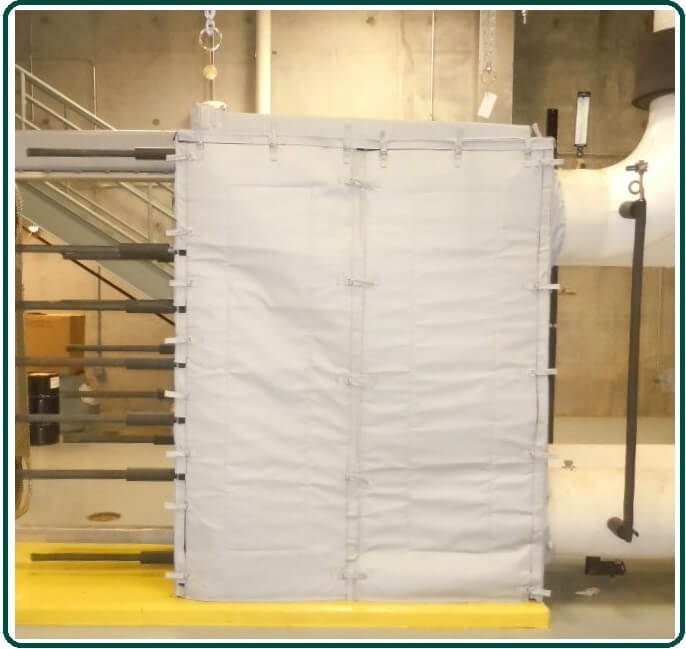
Heat exchangers must be adequately insulated to minimize heat loss. Since heat exchangers are routinely inspected and maintained, insulation is not practical at a stay.
Normally, the heat exchanger experiences a touch temperature that is different from the ambient temperature, with valuable heat likely to be carried away.
In the case of large heat exchangers or facilities with many units, the amount of energy loss may be substantial. Insulation coatings are one possible solution, although it has to be reapplied every time for maintenance which is costly and labor-intensive.
Custom-fit removable and reusable insulation is the most economical and efficient way to insulate heat exchangers allowing easy on and off application as maintenance is required.
Advantages of Plate Heat Exchanger:
- Heat Transfer Precise – Improved temperature outlook, correct counter-current flow, 80-90% less hold-up volume.
- Low Cost – Low capital investment, installation cost, limited maintenance, and operating cost.
- Greatest Reliability – Less fouling, stress, wear, and corrosion.
- Responsible – Least energy consumption for most process effects, low cleaning.
- Easy to expand capacity – Adjustable plate on an existing frame.
Disadvantages of Plate Heat Exchangers:
- Poor sealing may cause a leakage phenomenon, which will be replacement trouble.
- The use of limited pressure, generally no more than 1.5MPa.
- Limited operating temperature due to the temperature resistance of the gasket material.
- Short flow path and not suitable for gas-to-gas heat exchange or steam condensation.
- High blockage incidence, especially with suspended solids in liquids.
- The flow resistance is bigger than that of the shell and tube.
Frequently asked questions (FAQ) about plate heat exchangers (PHEs):
What is a plate heat exchanger (PHE)?
A plate heat exchanger (PHE) is a device that uses multiple thin, corrugated metal plates to transfer heat between two fluids. These fluids flow in separate channels and exchange heat through the plates’ surfaces.
How do plate heat exchangers work?
Plate heat exchangers work by directing two fluids through alternating channels formed between multiple plates. One fluid flows through even-numbered channels, while the other flows through odd-numbered channels. Heat transfer occurs through the plates’ surfaces due to the close proximity of the fluids.
What are the main advantages of plate heat exchangers?
Plate heat exchangers offer several advantages, including high efficiency due to their large heat transfer surface area, compact size compared to other types of heat exchangers, ease of maintenance with removable plates, and flexibility to handle varying flow rates and temperatures.
What are the different types of plate heat exchangers?
The main types of plate heat exchangers include gasketed plate heat exchangers (GPHE), brazed plate heat exchangers (BPHE), welded plate heat exchangers (WPHE), and semi-welded plate heat exchangers. Each type has specific advantages and is suitable for different applications based on factors like temperature, pressure, and fluid compatibility.
Where are plate heat exchangers commonly used?
Plate heat exchangers find applications across various industries, including HVAC systems, refrigeration, food and beverage processing, chemical processing, pharmaceuticals, power generation, and marine engineering. They are particularly valued in applications requiring efficient heat transfer and compact design.
What factors should be considered when selecting a plate heat exchanger?
Key factors to consider include the required heat transfer rate (capacity), operating temperatures and pressures, fluid compatibility, fouling tendencies, installation space constraints, maintenance requirements, and initial investment costs.
What are the limitations of plate heat exchangers?
Plate heat exchangers may have limitations such as potential leakage due to gaskets (in gasketed types), higher pressure drop compared to other heat exchanger types, limitations on operating temperature and pressure due to gasket material, and sensitivity to solids or particulates in the fluid stream.
How are plate heat exchangers maintained?
Maintenance of plate heat exchangers typically involves periodic inspections for leaks, cleaning of fouled plates, and replacement of gaskets (in gasketed types) as needed. Routine maintenance helps ensure optimal performance and longevity of the heat exchanger.
What are the alternatives to plate heat exchangers?
Alternatives include shell and tube heat exchangers, air-cooled heat exchangers, and spiral heat exchangers, each offering different advantages depending on specific application requirements such as fluid types, temperature differentials, and space constraints.
How do plate heat exchangers contribute to energy efficiency?
Plate heat exchangers are known for their high heat transfer efficiency, which minimizes energy consumption in heating or cooling processes. Their compact design and ability to handle varying flow rates efficiently contribute to overall energy savings in industrial and commercial applications.

